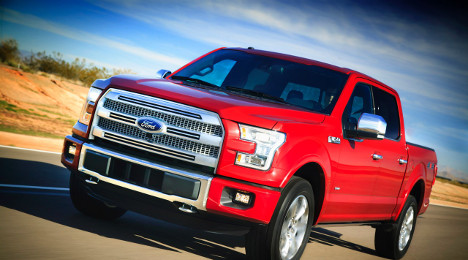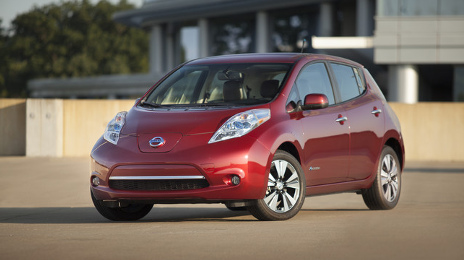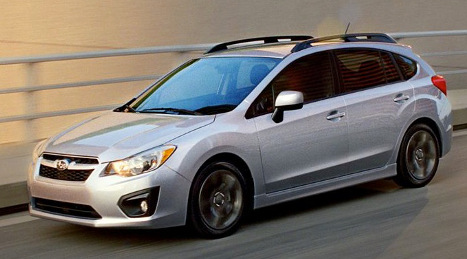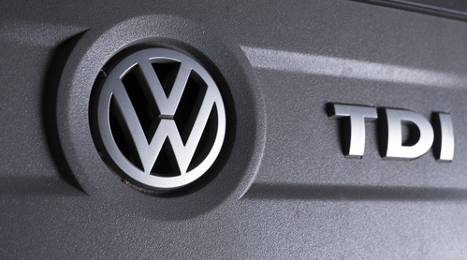Amid a strong certified pre-owned and overall used-vehicle sales market, wholesale prices continued to climb in October, driven in part by strong pickup residuals.
According to ADESA Analytical Services’ monthly analysis of wholesale vehicle prices by model class, auction prices were up 1.1 percent compared to September and 0.6 percent year-over-year. Vehicles at auction sold for an average of $9,744 last month.
According to the latest edition of Kontos Kommentary from ADESA Analytical Services’ Tom Kontos, this increase was driven largely be “upticks in truck prices.”
Take this stat into account: In October, wholesale prices for full-size pickups rose by 12.7 percent year-over-year to finish the month off at an average price of $14,469. Compact pickups saw rates spike by 6.5 percent from October 2014, coming in at an average of $7,793 last month.
Kontos explained that although pickups are out-performing the market, wholesale prices are looking stable all around.
“Still, wholesale values were solid in most model year and sale type categories, with the exceptions being off-rental risk and off-lease vehicles,” Kontos said.
And interestingly, though prices for trucks contributed to the overall price uptick, Kontos pointed out that car prices actually rose more than truck prices on a sequential basis.
For example, overall, car prices rose by an average of 0.6 percent year-over-year and 1.1 percent from September last month, while trucks were up 8.2 percent year-over-year but only 0.3 percent from September.
Among the cars, the full-size segment saw the biggest sequential increase, with rates soaring 11.7 percent over September prices.
Taking a look at auction prices by seller, Kontos reported prices for used vehicle remarketed by manufacturers were down 0.6 percent from September but up 5.2 percent year-over-year, “as off-rental program units sold had a solid month (though there were a lot of no-sales).”
Prices for fleet/lease consignors fell by 1.8 percent from September but were up 1.7 percent year-over-year.
“The off-rental risk price declines were driven mostly by higher mileage vehicles, while the off-lease price softness reflects growing supplies of these units,” Kontos further explained.
In light of expanding supply, prices for 3-year-old vehicles — a group which Kontos said is a “proxy for off-lease vehicles” — were down by 2 percent from September and 6.5 percent year-over-year.
Lastly, dealer consignors saw an uptick in prices in the lanes last month, with rates rising by 0.7 percent versus September and 2.8 percent year-over-year.
To borrow from “Sesame Street,” one of these things is not like the others.
Surrounded by mostly trucks and larger vehicles, the model at the top of the heap of auction price strength in the third quarter was the Nissan LEAF, according to Kelley Blue Book.
Its latest Blue Book Market Report indicates that KBB Auction Values on the LEAF were up 5.1 percent in Q3, making the all-electric car No.1 on the list of top performing models for the quarter.
KBB’s rankings — which are based on values for 2012-2014 model-year vehicles — have the Ford E150 Cargo in second (up 4.4 percent), the GMC Sierra 1500 Double Cab in third (up 2.3 percent) and two more pickup trucks in a tie for fourth: the Chevrolet Silverado 1500 Double Cab and Nissan Titan King Cab (both up 1.7 percent).
Conversely, the Suzuki SX4 had the biggest drop-off in auction prices during the quarter, as its values fell 14.9 percent. The Ford F-250 Super Duty Regular Cab wasn’t far behind (down 14.2 percent).
The complete lists from KBB are below, with model name and value change included. Again, rankings are based on KBB Auction Values for 2012-2014 model-year vehicles.
Top 10 Performing Models:
MAKE MODEL Q3 Change (%)
Nissan LEAF 5.1%
Ford E150 Cargo 4.4%
GMC Sierra 1500 Double Cab 2.3%
Chevrolet Silverado 1500 Double Cab 1.7%
Nissan Titan King Cab 1.7%
Infiniti QX 1.6%
Nissan NV2500 HD Cargo 1.2%
Chevrolet Express 1500 Passenger 1.0%
Nissan NV1500 Cargo 0.9%
Chevrolet Express 2500 Passenger 0.9%
Bottom 10 Performing Models:
MAKE MODEL Q3 Change (%)
Suzuki SX4 -14.9%
Ford F250 Super Duty Regular Cab -14.2%
Ford F250 Super Duty Super Cab -12.6%
Toyota Prius Plug-in Hybrid -12.4%
Ford Fiesta -12.3%
Ford F350 Super Duty Super Cab -11.9%
Suzuki Kizashi -11.4%
Ford Fusion Energi -11.3%
Mitsubishi Eclipse -11.3%
Mitsubishi Galant -11.1%
Wholesale prices were on the way up last month, and that marks the fifth month in a row auction prices have spiked.
This increase brought the Manheim Used Vehicle Value Index up to 125.3, which is exactly where it started 2015, and up 2.9 percent from October of 2014, on a mix-, mileage- and seasonally adjusted basis.
“Continued strength in wholesale pricing is reflective of higher new-vehicle transaction prices and a rewarding retail used vehicle environment. Higher wholesale prices, narrower gross margins and record dealership profits are evidence that the benefits of increased dealership efficiency are being passed on to consumers and enabling dealers to bid up prices in the wholesale market,” explained Tom Webb, chief economist at Cox Automotive, in his analysis of the month’s auction price movement.
“Greater confidence in their ability to turn a vehicle at a given price within a set period of time allows dealers to reduce the risk discount incorporated into any wholesale bid,” he added.
Webb also pointed out that auction volumes for rental-risk units last month were down significantly from last October, “since last year’s normal August and September de-fleeting was pushed into October due to several recalls that impacted many units in the rental fleet.”
Auction prices for rental-risk units, adjusted for mileage and mix, experienced what Webb called a “normal seasonal decline” in October, but were still up 0.7 percent year-over-year.
“There was a smaller monthly decline in the straight average of rental risk pricing than in mix-adjusted series since pickups, crossovers and vans accounted for a greater share of off-rental volume in October than in September,” Webb explained.
As far as segment changes go, Webb shared that compact cars remain the weakest segment — and that goes for recent months and 2015 as a whole. Compact car prices fell by 5.6 percent year-over-year last month.
The midsize cars experienced a stronger performance, with prices rising by 3.5 percent from October 2014.
Pickups continued to lead the market with an 11-percent spike in prices at auction last month.
As far as the high-end market goes, luxury cars, which saw prices rise by 0.7 percent in October, experienced a bit of a reprieve from what has been a weak performance this year.
“Although wholesale pricing for luxury cars has been soft during the past year, October was relatively good. Don’t expect that trend to continue given the influx of off-lease luxury units that will come in November and December,” Webb cautioned.
Manheim also touched on relative pricing strength by price tier, which is estimated based on average mileage per tier. Webb said pricing strength in October was “fairly consistent” for all price points.
“And, unlike most months, there was no relationship between pricing and auction volumes for the various price tiers,” he said.
And taking a look at straight average of auction pricing in October versus a year ago, Webb shared this metric is up considerably more than the Manheim Index.
Why? Webb said this year’s sales included more lower-mileage, and higher-end units.
“Dealer-consigned vehicles, in particular, posted strong pricing in October,” Webb said. “Average mileage on those units was lower than it has been in the past two years as dealers received newer trade-ins.”
Auction values dropped to a two-year low in the third quarter, but there were a few brands and segments bucking the trend and holding on their values well.
Kelley Blue Book took a look at one brand, in particular, in its latest Blue Book Market Report — Subaru.
For price retention, some Subaru models are tops in the midsize and compact segments. For reference, midsize car prices for models 1- to 3-years-old fell by 6.1 percent in Q3, while compact car prices fell by an average of 6.7 percent.
Though these segments have seen some pretty hefty price declines this year, when comparing the top five 2014 model-year vehicles from both the midsize and compact segments, retention remains strong. This is especially true for the Subaru Impreza and Legacy.
The Impreza topped the list, retaining 73.8 percent of its value, while the Legacy came in at No. 2 with 72.5 retained value.
KBB analysts pointed out retention values within the two segments range from 73.8 percent down to 56.8 percent with an average of 65.6 percent between both mid-size and compact segments.
“Overall, there is no discernable trend as to which segment outperforms when looking at the top five performers from the compact and mid-size segments,” said Sean Foyil, KBB analyst.
Rounding out the top five strongest performers in the two segments were the Scion xB in the No. 3 slot (69.7 percent), followed by the Scion tC (65.5 percent) and the Honda Accord (65.1 percent), respectively.
As used supply expands, wholesale prices continue to slide. In fact, rates in the lanes hit a two-year low in the third quarter.
That’s according to Kelley Blue Book’s Q3 Blue Book Market Report, which showed auction values for 1- to 3-year-old vehicles fell by an average of $850 or 4.3 percent in the third quarter.
And average values were lower than what was seen in both Q3 2014 and Q3 2013. Specifically, rates averaged $38 lower than the third quarter of 2014, and $349 lower than prices during the same period of 2013.
And though rates have dropped to more normal levels after prices skyrocketed in light of tight supply due to the Great Recession, KBB analysts reassured the industry the declines are nothing to be worried about.
“While auction values are maintaining a two-year low, we’re not seeing anything out of the ordinary from a valuation perspective,” said Sean Foyil, analyst for Kelley Blue Book. “Auction volume has consistently been up this year when compared to previous years, and that means more supply in the lanes, which can ultimately cause values to soften.
“Additionally, as we see each year, auction values typically follow a seasonal pattern where they tend to maintain a steady decline throughout the third quarter and into the end of the fourth quarter.”
Taking a look at price movement by segment, the overall average segment decline over Q3 was 4.7 percent, but Foyil shared, “Both the midsize and full-size pickup truck segments significantly outperformed the used-car market in the third quarter.”
For much of 2015, this has been the case, and Q3 was no exception. Midsize trucks only saw prices fall by 1 percent last quarter, while full-size truck rates dropped by just 1.7 percent.
“This is in line with what we have seen throughout the year, due to a lower supply and increased demand for mid-size and full-size trucks,” said Foyil.
Among the midsize trucks, the Nissan Frontier and Toyota Tacoma came out on top, according to KBB data, with prices falling by 1 percent and 0.7 percent during Q3, respectively.
And for full-size trucks, the Dodge Ram 3500, GMC Sierra 1500 and the Chevrolet Silverado 2500 were the best performers, with rates spiking by 2.3 percent, 1.7 percent and 1.7 percent, respectively.
The SUV and crossover segments — except for compact SUV/crossovers, which fell by 4.8 percent — followed relatively closely behind the truck segments with price declines ranging from 3.1 percent to 4 percent.
The sports car segment took the biggest hit in Q3, with prices falling by 8.9 percent as summer came to an end. The subcompact cars also took a plunge, with rates falling by 7.2 percent in Q3.
And according to the latest Black Book Market Insights report, auction value declines are not slowing down.
In fact, last week, cars and trucks both experienced the largest declines so far this year. Car prices dropped by an average of 0.91 percent or $99, while trucks fell by 0.69 percent or $108.
The compact car and entry midsize car segments saw the biggest declines with both segments seeing a 1.38-percent drop. The full-size segment performed the best among the cars, with a drop of just 0.20 percent or $18.
For trucks, the compact pickup (zero percent change) and compact SUV (0.01-percent decline) segments saw prices hold steady. The minivan cargo segment pulled average prices down a bit, as it posted a 2-percent ($102) drop last week.
Comments in the lanes illustrated the downward trends in auction price, as Black Book editors overheard an auction attendee from Pennsylvania note, “Prices were low here today, dealers selling at almost any price to reduce inventory.”
The Trade-In Marketplace will soon have a new name, and with that, an entirely new experience for consumers and toolset for dealers.
The program is being converted into “Kelley Blue Book Instant Cash Offer” during the fourth quarter, Cox Automotive Media Group leadership told a gathering of media on Thursday at its Atlanta headquarters, and the transition is expected to be completed by the end of December.
This follows extensive testing on both the KBB and Autotrader websites, which has uncovered has provided a great deal of insight.
Scott Ehlers, the group’s vice president of product, said that “we know now how to best position this” for both dealers and consumers, alike.
“We do a lot of research. We’ve done more research in the last year and testing in market than we ever have before,” Ehlers said. “So, the product that will actually come to bear in the market will be better tested and actually better positioned, we believe.”
One point of research: the new name, itself, paints a better picture of what the tool actually does: “Get to the instant cash offer. Let’s call it what it is,” Ehlers said. “Better alignment, less questions.”
Cox Automotive Media Group president Jared Rowe followed up, emphasizing how the aim is to push “high-quality” traffic to dealerships, which the company believes should be the “center of the disposal process.”
“When one of your sister companies is one of the largest remarketers in the world, it really is useful and you think about doing these sorts of things,” Rowe said. “Because what it does is, it positions us to help our clients in a way that we don’t think others are positioned, because this ultimately about driving high-quality showroom traffic into our retailers.”
That traffic could come in a couple of different forms, he explained.
First, he said, is the customer who wants to trade-in their vehicle and buy another car. There’s also the consumer who might not need another car, but simply needs to get rid of his or her existing ride — that, in and of itself, is a point of “access to inventory” for dealers, who perhaps are already scouring Craigslist or local newspapers for consumers trying to sell their car.
“And the second thing is, while I may not think I want to buy another vehicle, it’s at least an at-bat,” Rowe said, with the nicely timed baseball analogy.
“You’ve got somebody who’s showing up that you have an opportunity to build a relationship with in some way shape or form and either sell them another car or position yourself so that you are the retailer of choice in the future, because the experience was so good when they needed to dispose of their vehicle,” he added. “But again, we think that it’s important to put the dealer at the center of the disposal process.”
'Liquid cash offer with context'
But as mentioned earlier, it goes beyond a name change. For example, Rowe said, the company has “rationalized the values.”
While the consumer is certainly trying to determine what his or her car is worth, he or she is also seeking to have “confidence” in the actual value, Rowe said. The consumer is provided “market context” through what KBB offers.
“You’re seeing us put the range inside (the offer), next to the Trade-In Marketplace value. So, it’s not just a liquid cash offer; it’s a liquid cash offer with context, which is incredibly important,” Rowe said. “Because if we provide context, it helps set the consumer up for the right conversation. It means the retailer is starting from a slightly different place when they have the conversation with the consumer about what the value of the vehicle is, because ultimately, there still is a condition assessment when the consumer brings the vehicle in.”
Another change is that the company has “optimized the funnel” by reformatting the questions in the vehicle condition quiz for consumers. The questions were rephrased to be “more intuitive” for the shopper.
The company also added some education elements to the overall experience to help set the expectation properly for what the car might be worth.
Using it as trade-in generator
What about dealers who were utilizing the Trade-In Marketplace more as a way to generate inventory?
“We think what drives the traffic – in this case, to get them inventory – is an Instant Cash Offer the customer is going to act on,” said Steve Lind, executive vice president of operations for the group.
He says the experience and the vehicle value provided by KBB can help as motivation for the consumer to make that active decision to take their car to the dealership.
From the marketing and advertising vantage point, will the fact that KBB Instant Cash Offer can be a viable way to help generate inventory certainly still be point of emphasis? Will there still be a push for that?
“Absolutely,” Eddie Tyner, the senior vice president of media sales for the group. “We think that that rebranding is going to significantly increase the number of offers we’re able to make, because the Kelley Blue book brand has such strength, and it’s going to lend a lot of credibility to the program.
“And that will be a big benefit to dealers,” said Tyner. “Dealers are excited about the change, and I think they’re going to get a huge benefit from that.”
He added: “I think they’re going to take a lot of the offers, because they’re going to be legitimate offers. But even in those cases where they don’t, the improvement that they will get in terms of people walking through the door — Jared calls them ‘at-bats’ — they will get huge benefits then.”
Car values declined at a normal seasonal pace last week, while pickup trucks continued to hold their value.
But one segment that has been stable for most of the year is beginning to see prices drop a bit more in the lanes: SUVs.
Anil Goyal, vice president of automotive valuation and analytics at Black Book, said in the company’s latest Market Insights report, “We saw normal declines in the wholesale market last week, which are consistent with seasonality expectations. SUV values that have recently been stable have begun to show some softness.”
Overall last week, car prices dropped by 0.54 percent or $59, while trucks experienced a decline of 0.47 percent or $74. This marks a better performance than trucks saw the prior week, when price drops came in at an average of 0.62 or $97.
To better understand Goyal’s analysis on SUV price movement, take the following stats into account:
- Compact SUVs saw the biggest price drop of any segment last week, with rates falling by 1.53 percent or $300.
- This segment was followed by the full-size SUVs with a decline of 1.18 percent or $223.
Pickups trucks continued to be some of the best performing segments at auction:
- Compact pickups were one of the best performing segments with a decline of just 0.22 percent or $32.
- Full-size pickups only dropped in price by 0.26 percent or $48 last week.
Taking a look at the car segments, the 0.54-percent decline was lower than the average weekly depreciation rate of 0.64 percent seen over the previous four weeks, Black Book pointed out.
The worst performing segments for cars were the full-size (down 1.19 percent or $106), entry level (down 0.85 percent or $53) and sporty car (down 0.70 percent or $108) categories.
The best performing car segment last week was the near luxury car category, whose rates only dropped by 0.22 or $36.
It seems sentiment from the auction lanes and on the lots is in line with the seasonal lull often experienced in early to mid-fall.
Black Book editors overheard a buyer from Michigan note, “Fairly good day for truck sales, but some models didn’t do as well as dealers had hoped for,” while an auction attendee from Tennessee said, "Dealers report that retail has been a little slower this week in this area.”
The auction lanes are showing some interesting trends when it comes to price movement, including increasingly sharp depreciation for certain Volkswagen diesel models in light of the ongoing emissions scandal, and a shifting truck market.
The latest Black Book Market Insights report took a look, in particular, at two movements in the market: the depreciation trends of the aforementioned VW diesel models, and overall “steep” price declines at auction across the market — even for trucks.
Though last week, prices for cars at auction fell by 0.63 percent or $70 — which is similar to the average weekly depreciation seen over the previous month — trucks, on the other hand, were hit much harder than usual.
Overall truck prices fell by 0.62 or $97, which is much higher than the average depreciation rate of 0.35 percent seen over the previous four weeks.
“This past week we saw a steep decline in the market impacting most segments with only a few bright spots in some segments,” said Anil Goyal, vice president of automotive valuation and analytics.
These “bright spots” included a couple car and truck segments.
The upper midsize and premium sporty cars were the best performers out of the car segments, with rates declining by only 0.26 percent and 0.28 percent, respectively.
For trucks, the compact SUVs and midsize pickups showed the best performance, with rates dropping by 0.07 percent and 0.19 percent, respectively.
Though trucks are now seeing depreciation more in line with the car segments, this hasn’t been the case through most of the year. To illustrate how truck and car price movement has varied, Black Book editors took a look at compact cars versus full-size pickups trucks.
“Compact cars held steady through the first half of the year, largely due to the spring tax season, but have fallen sharply since,” the report stated, while full-size pickup trucks saw some of the strongest residuals in the market through the first two quarters.
Now, it seems, the trend might be evening out. Last week, compact cars only dropped in price by 0.50 percent or $38, while full-size pickups saw a decline of 0.76 percent or $142.
Black Book also took a look at depreciation for specific VW diesel vehicles impacted by the recent emissions situation.
The report shows that since the news regarding VW broke on Sept. 18, each vehicle Black Book has tracked displayed a higher level of depreciation compared with its competitive gas models. Comparisons from Black Book are as follows:
Golf Diesel: -8.7 percent
Gas Models: -3.7 percent
Jetta Diesel: -13.8 percent
Gas Models: -3.7 percent
Beetle Diesel: -9.3 percent
Gas Models: -3.2 percent
Passat Diesel: -13.5 percent
Gas Models: -2.8 percent
Amid the evolving diesel emissions scandal involving Volkswagen’s TDI models, many analysts are watching the situation closely for any dramatic shifts in these models' residuals and sales.
In other words, what impact will the alleged “defeat device” software and the resulting firestorm from regulators and the EPA have on consumer and dealer interest in the models.
Auto Remarketing reported Monday that dealers in the lanes are already being much more cautious about purchasing certain VW models.
And Kelley Blue Book analyst Tim Fleming said, “Early indications from auctions are that dealers are more hesitant to buy the VW diesel units, with sale prices falling 13 percent in the two weeks following VW’s announcement, compared to a 2-percent drop for the comparable gas-powered models.”
Black Book editors offered their take on the situation in the latest weekly Black Book Market Insights report, showing wholesale value trends on VW diesel models impacted by the EPA notification versus competitive gas models in the same segments.
The results were telling, with each model studied showing higher depreciation than their gas counterparts.
For example, prices for the Jetta Diesel have dropped by 7.9 percent since the news broke in late September. From that same Sept. 18 date, competitive gas models have seen prices drop by only 3.5 percent.
The Beetle Diesel is suffering, as well. The model has depreciated by 6.5 percent since the end of September, while competitive gas models have only dropped by 2.3 percent during the same period.
Lastly, the Passat Diesel saw similar drops, with a depreciation rate of 7.9 percent. On the other hand competitive gas models for this unit only fell by 2.3 percent since Sept. 18.
Auction sales suffering for VW TDI models
NADA Used Car Guide analysts also offers a VW emissions scandal update in the latest Guidelines Report, which stated damage to VW’s used-vehicle prices — both for affected diesel engine models and gas powered models not impacted by the scandal.
“Unfortunately the relatively small number of VW diesels passing through the used market combined with uncertainty surrounding VW’s plan to bring affected vehicles into compliance make it difficult to pinpoint how disruptive the issue has been to the used VW market thus far,” writes Jonathan Banks, senior director of vehicle analysis and analytics at NADA UCG and speaker at the upcoming Used Car Week Conferences. “To-date, there is some indication that VW auction sales activity has been affected, however, any impact to VW prices remains inconclusive.”
Take this for example: VW auctions sales for model years 2009-2015 fell by an average of 7 percent over the two-week period ending Oct. 3, when compared to levels averaged in the four weeks prior, according to the Guidelines report.
“While well above the 1 percent drop recorded for the industry as a whole, VW’s decline was matched or exceeded by a handful of brands including GMC, Infiniti, Mercedes and Subaru,” Banks added.
When looking strictly at changes for VW diesel models, the drops were more pronounced.
Sales of VW Beetle, Golf, and Jetta diesel models were off by 28 percent, Banks reported, while sales of gas models were flat. Sales of Passat diesel and gas variants were down 33 percent and 18 percent, respectively.
Auction volume of VW’s compact cars in the lanes, including both gas and diesel variants, is also waning. Volume fell by an average of 4 percent over the aforementioned two-week period.
That said, VW wasn’t the only brand to experience a drop in compact car value, as Mazda saw a 2-percent decline and Toyota experienced a 3-percent volume drop in this segment.
“In terms of pricing, a careful review of used retail and wholesale price movement has yet to reveal any consistent change in the trajectory of VW prices — diesel or otherwise — compared to the competition,” Banks said in the report. “Additional time will have to pass before we can draw more definitive conclusions on the issue.”
If interested in further coverage on the Volkswagen TDI issues, see the recent Auto Remarketing features below:
VW inquiries up 10% at KBB, 7% at Autotrader
VW diesel issue impact on CPO & prices
How VW gas & diesel prices are faring at auction
VW’s diesel refit plan draws questions
Though this trend has probably been on your radar for a while now, this statistic really drives the point home. In September, some truck segments showed a smaller year-to-date depreciation rate than the hit cars took in just a month.
Black Book offered this comparison in its breakdown of September price movement for model years 2010 through 2014. The compact car segment, which experienced the biggest depreciation rate in September, saw prices fall by 3.7 percent to an average of $8,923, while compact pickup prices have only dropped by 2.9 percent for the whole year.
These car and truck trends are continuing into October, as the latest Black Book Market Insights report shared car prices dropped by 0.76 percent last week, which is much higher than the average weekly depreciation of 0.47 percent seen over the previous 12 weeks. Trucks, on the other hand, saw prices drop by just 0.40.
Looking at overall average price movement for September, according to Black Book data, the average price of a used vehicle for model years 2010-2014 fell by 1.5 percent this past month, which stayed pretty consistent with August’s decline of 1.6 percent.
“Overall vehicle depreciation continues to hold up well, especially as we near the part of the year where heavier price drops are typically expected,” said Anil Goyal, vice president of automotive valuation and analytics for Black Book. “It’s very telling of the disparity between cars and trucks to see that we have some truck segments showing lower annual depreciation than what cars are seeing on a monthly level.”
The car segments saw average depreciation of 2.3 percent, while truck prices dropped by only 1 percent in September.
Compact cars led all segments with the highest depreciation for the month overall, while the full-size SUVs and full-size passenger vans held prices up the strongest in September. It is also important to note compact cars have seen prices drop by 16.9 percent year-over-year through September.
Full-size SUVs and full-size passenger vans each saw a 0.5-percent drop in price. Full-size SUVs ended the month with an average price of $26,512, which is a 3.7-percent drop from year-ago levels.
And among the car segments, the best performing units were the premium sporty cars, showing a 1.2-percent drop from August. This segment finished the month with an average price of $42,253, down 14.2 percent year-over-year.











